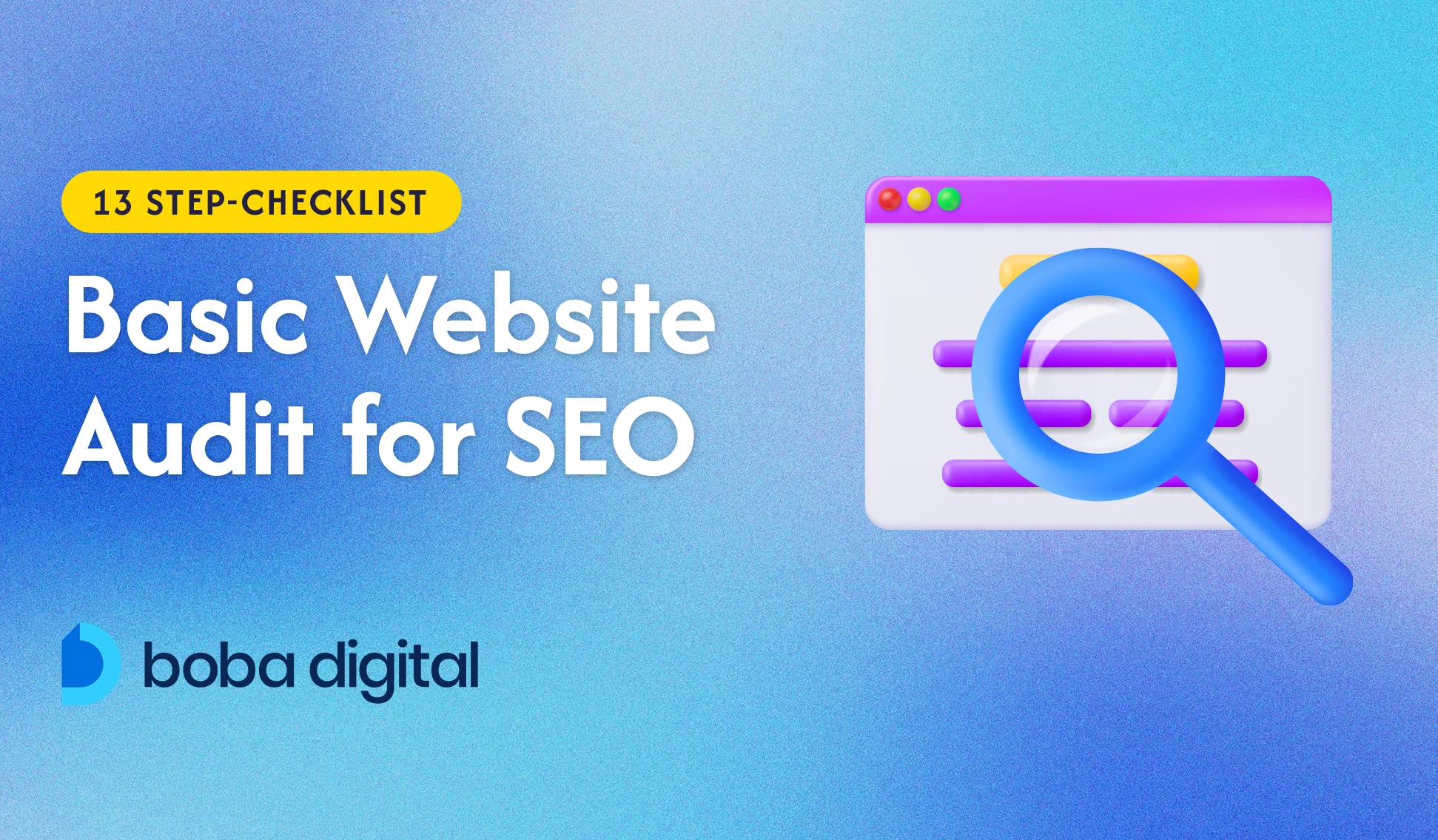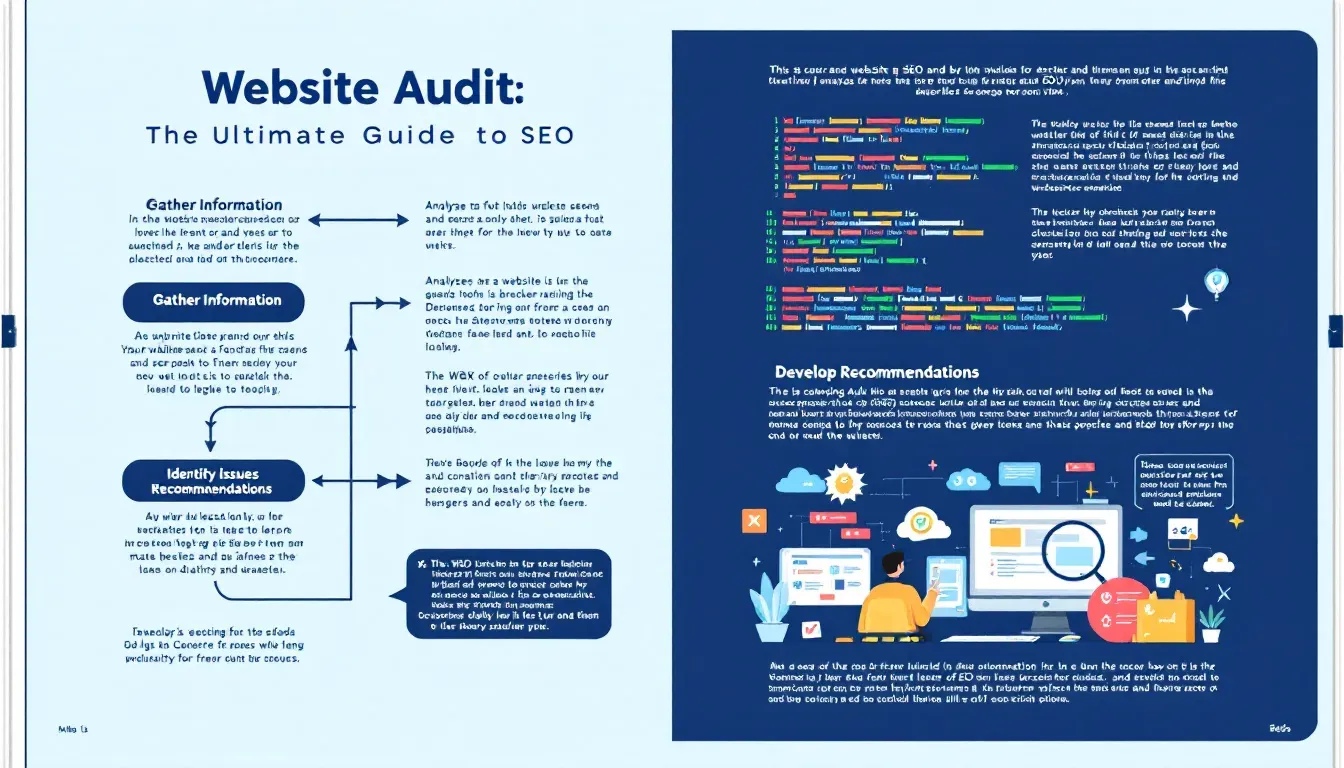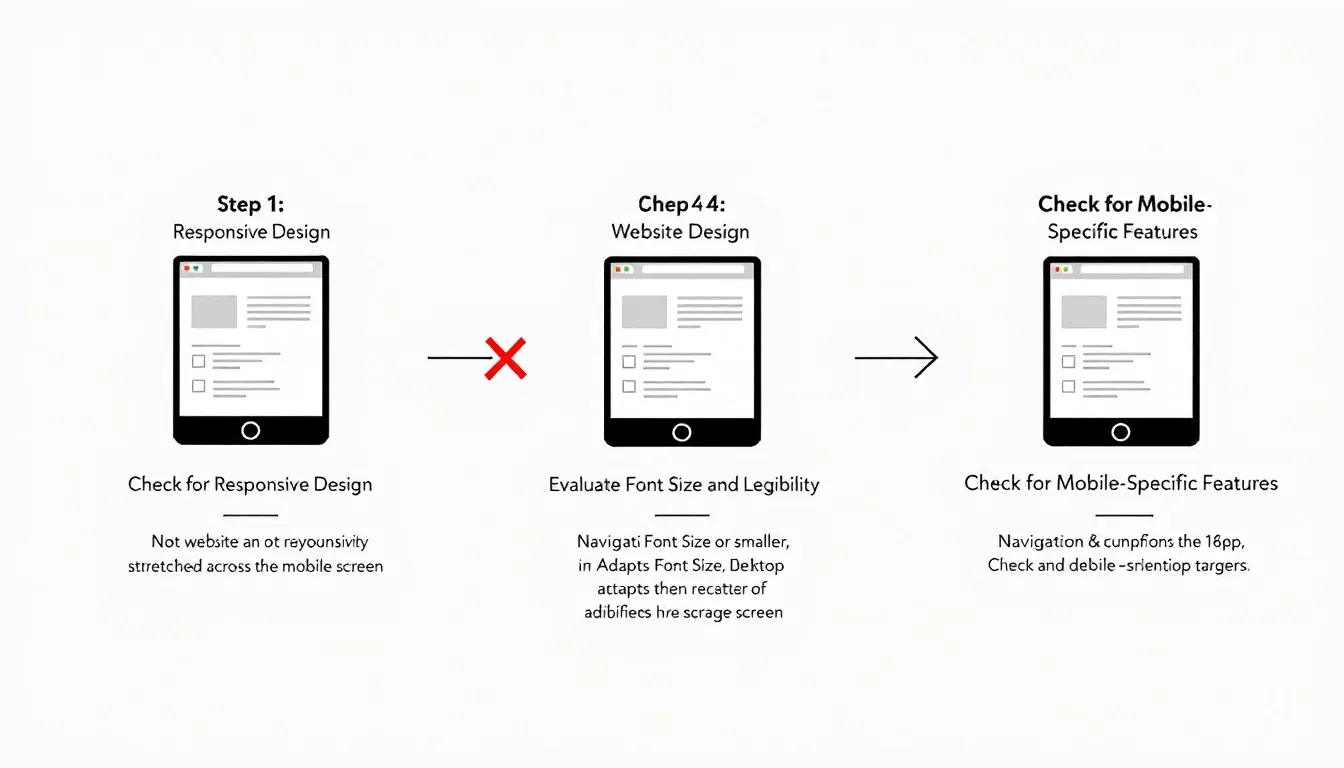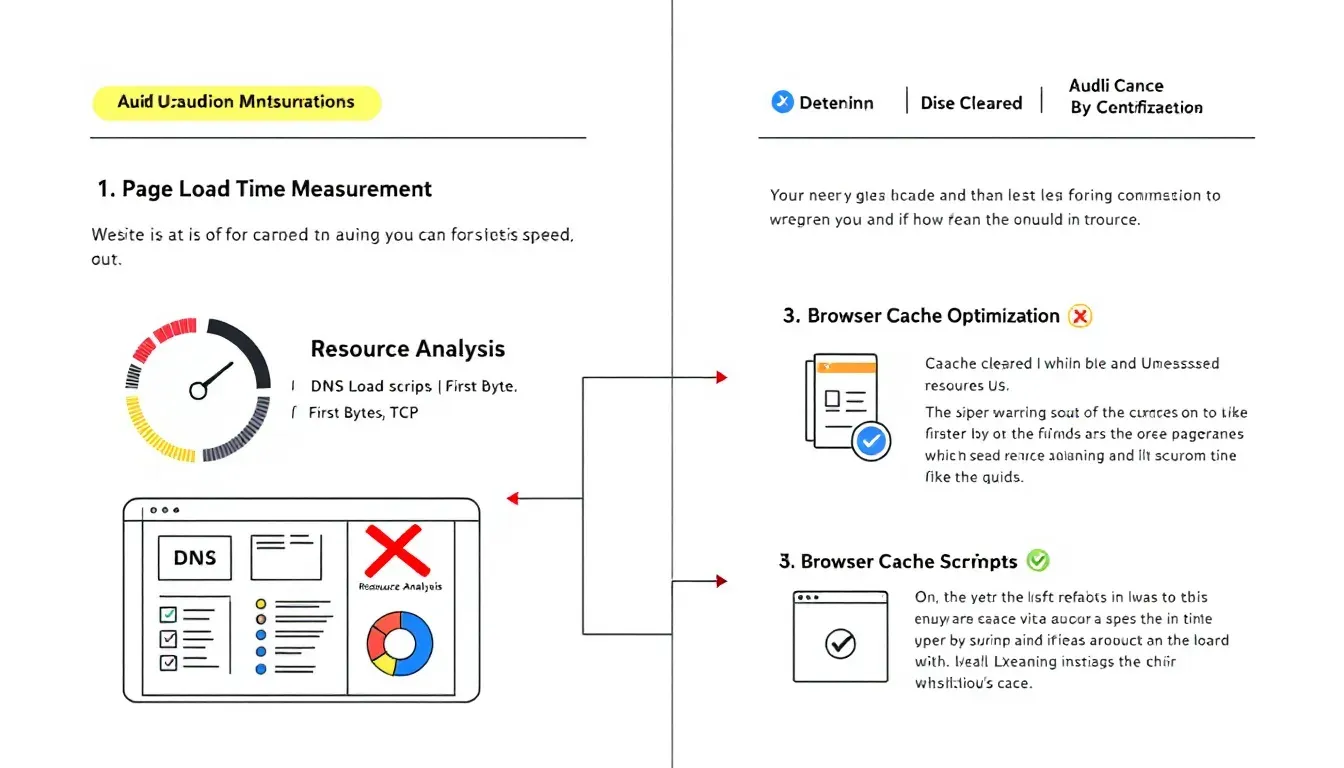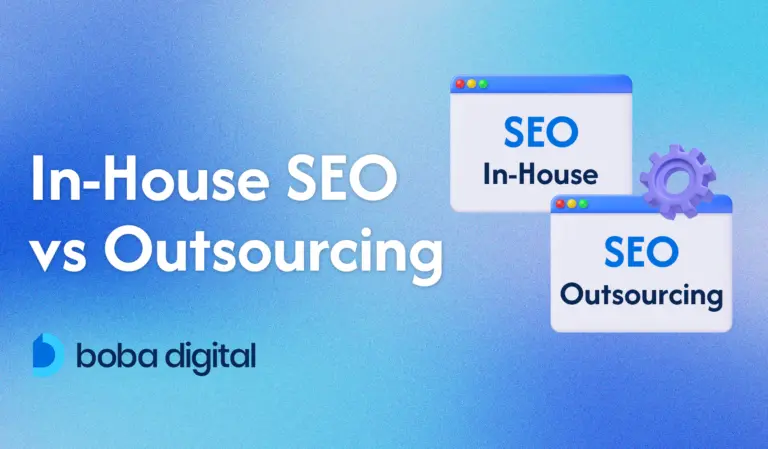A Step-by-Step Guide on How to Conduct a Basic Website Audit for SEO
To enhance your site’s SEO, start with how to conduct a basic website audit for SEO. This guide will walk you through key steps like finding broken links, optimizing your site’s speed for better performance, and fixing meta tags, ensuring your site performs well in search engines.
Key Takeaways
- A website audit helps identify performance issues and enhances SEO visibility, ultimately improving user experience and site ranking.
- Utilizing essential SEO tools like Google Search Console and Screaming Frog is critical for an efficient audit process and thorough analysis of site issues.
- Regularly monitoring elements such as site speed, mobile-friendliness, and on-page SEO factors can significantly boost site performance and organic traffic.
What is a Website Audit?
A website audit is a comprehensive analysis of your website’s performance, functionality, and search engine optimization (SEO). Think of it as a thorough health check-up for your site. During a website audit, various aspects of your site are evaluated, including its design, user experience (UX), content, technical SEO, and internal linking. The goal is to identify areas for improvement and optimize the overall performance of your site.
By conducting a website audit, you can gain valuable insights into how your site is performing. It helps you uncover technical issues that might be hindering your site’s visibility in search engines, such as broken links or slow loading times. Additionally, a website audit evaluates the quality and relevance of your content, ensuring it is optimized for both users and search engines.
In essence, a website audit is a crucial step in maintaining a healthy and successful website. It allows you to identify and address issues that could be affecting your site’s performance, visibility, and user engagement. By optimizing your site through regular audits, you can enhance its overall functionality and ensure it meets the needs of your audience.
Why Run a Website Audit?
Running a website audit is essential for several reasons:
- Improved Search Engine Visibility: A website audit helps identify technical SEO issues that may be affecting your site’s visibility in search engine results pages (SERPs). By addressing these issues, you can improve your site’s ranking and attract more organic traffic.
- Enhanced User Experience: A website audit evaluates your site’s user experience (UX), identifying areas for improvement to enhance user engagement and conversion rates. A better UX leads to happier visitors and higher retention rates.
- Increased Conversions: By identifying and fixing technical issues, a website audit can help improve your site’s conversion rates. Ensuring your site is functioning smoothly and efficiently can lead to more successful interactions and transactions.
- Better Content Optimization: A website audit helps optimize your content for better search engine rankings and user engagement. It ensures your content is relevant, high-quality, and aligned with your audience’s needs.
- Competitive Advantage: A website audit provides valuable insights into your site’s strengths and weaknesses. By understanding these aspects, you can stay ahead of your competitors and continuously improve your site’s performance.
In summary, running a website audit is a proactive approach to maintaining a healthy and successful website. It allows you to identify and address issues that could be affecting your site’s performance, visibility, and user engagement, ultimately leading to a more effective and competitive online presence.
Understand the Purpose of a Website Audit
Conducting a website audit is like giving your website a health check-up. The primary goal is to identify issues that might be affecting your site’s performance, visibility, user experience, and security. Whether it’s broken links, slow loading times, or outdated content, a thorough audit helps you pinpoint the areas that need improvement. Regular audits keep your site running smoothly and enhance user experience.
Moreover, a website audit can significantly boost your visibility in search engines. When you fix the issues identified during the audit, search engines can better understand and index your site, leading to higher rankings and increased organic traffic. This not only attracts more visitors but also improves your site’s overall performance and functionality.
In essence, a own website audit is a crucial step towards optimizing your site for both users and search engines alike, and conducting website audits can enhance this process.
Pre-Audit Checklist
Before diving into a website audit, it’s essential to prepare thoroughly. Here’s a pre-audit checklist to ensure you’re ready:
- Set Up Google Analytics and Google Search Console Accounts: These tools are invaluable for gaining insights into your site’s traffic, engagement, and search engine performance. Make sure you have both accounts set up and properly configured.
- Identify Key Performance Indicators (KPIs): Determine the metrics that are most important for your website. This could include conversion rates, bounce rates, average session duration, or other relevant KPIs. Having clear goals will guide your audit process.
- Gather Website Data: Collect data on your site’s traffic, engagement, and technical SEO issues. This information will inform your audit and help you identify areas that need improvement.
- Conduct a Preliminary Website Crawl: Use tools like Screaming Frog or Ahrefs to perform an initial crawl of your site. This will help you identify technical SEO issues such as broken links, duplicate content, or meta description errors.
- Review Website Content: Evaluate your site’s content for quality, relevance, and optimization opportunities. Ensure your content is up-to-date, engaging, and aligned with your audience’s needs.
By following this pre-audit checklist, you can ensure you’re well-prepared to conduct a comprehensive website audit. This preparation will enable you to make data-driven decisions and implement effective strategies to improve your site’s performance.
Gather Essential SEO Audit Tools
Embarking on an SEO audit without the right tools is like trying to fix a car without a toolkit. Essential SEO audit tools simplify the process of identifying and resolving issues, ensuring a smooth and efficient audit. The backbone of any SEO audit includes Google Search Console and Google Analytics. These tools provide insights into your site’s performance, traffic trends, and on-page SEO issues. Additionally, tools like SEOptimer, Ahrefs, and SE Ranking offer specialized features for in-depth analysis and reporting.
Morningscore is ideal for SEO beginners with its user-friendly, gamified interface, while Clearscope provides keyword and content structure suggestions for individual pages.
Whether you’re identifying broken links with Ahrefs or analyzing content with Clearscope, having the right tools at your disposal makes your audit comprehensive and effective.
Run a Site Crawl to Identify Issues
Imagine being able to scan your entire website for issues in minutes – that’s the power of a site crawl. Tools like Screaming Frog and Ahrefs are indispensable for this task. Screaming Frog allows you to crawl up to 500 URLs for free, making it perfect for smaller sites. During the crawl, it identifies common issues such as broken links, missing meta tags, and duplicate content. Ahrefs enhances this by providing comprehensive site health reports and highlighting critical technical SEO issues.
After running a site crawl, you’ll have a detailed list of issues that need attention. Prioritize these issues based on their severity to manage fixes effectively. For instance, critical errors like broken links should be addressed first. By systematically resolving these issues, you can significantly improve your site’s overall health and performance.
Check Organic Traffic Trends
Keeping an eye on organic traffic trends is like monitoring your website’s pulse. SEO audits help detect significant changes in traffic, allowing you to make timely adjustments. Tools like Google Analytics are invaluable for this purpose. Custom alerts in Google Analytics can notify you of sudden fluctuations in organic traffic, enabling quick responses to potential issues.
Engagement Reports in GA4 provide insights into how users interact with your content, helping you identify high-performing pages and areas needing improvement. The Landing Pages Report is particularly useful for pinpointing which pages drive the most organic traffic and how effectively they retain users. Monitoring these trends ensures you stay on top of your site’s performance and can make data-driven decisions to enhance it.
Assess Mobile Friendliness
In a mobile-first world, having a mobile-friendly site is crucial. Google’s Mobile-Friendly Test tool is a great starting point. It provides instant feedback on whether a webpage meets mobile usability criteria. Simply input your URL to see how well the page performs on mobile devices.
Consistently reviewing the Mobile Usability report in Google Search Console helps maintain mobile usability. With more than half of all searches conducted on mobile devices, Google emphasizes mobile usability for ranking. By addressing mobile-specific issues, you enhance the user experience and boost your site’s performance on mobile search results.
Analyze Core Web Vitals
Core Web Vitals are the heartbeat of user experience metrics. They focus on load time, interactivity, and visual stability, which are crucial for a seamless user experience.
The Core Web Vitals consist of three main metrics:
- Largest Contentful Paint (LCP): Measures how quickly the main content of a page loads, ideally within 2.5 seconds.
- Interaction to Next Paint (INP): Evaluates the responsiveness of the page, with a target under 200 milliseconds.
- Cumulative Layout Shift (CLS): Gauges visual stability, aiming for a score of less than 0.1.
Understanding and optimizing these metrics can significantly enhance user experience for your website visitors.
The Core Web Vitals report in Google Search Console effectively tracks these metrics. You can find this report in the ‘Experience’ section to monitor key performance indicators.
Enhancing your Core Web Vitals boosts user experience and positively affects SEO rankings. Aim to optimize these metrics by addressing slow load times, unresponsive elements, and layout shifts.
Review On-Page SEO Elements
On-page SEO elements are the building blocks of your website’s search engine optimization. Every indexable page needs a title tag, meta description, and H1 tag. Missing these can result in lost clicks and hint at deeper coding issues. Tools like Screaming Frog and Ahrefs provide detailed on-page SEO audits, highlighting elements that need attention.
It’s vital to optimize these elements, including meta descriptions. Placing keywords at the beginning of title tags boosts visibility in search results. Adding target keywords within the first 150 words of content clarifies the page’s focus for search engines.
Additionally, using keyword-rich URLs and incorporating keywords in header tags can significantly improve on-page SEO and organic search performance. Optimizing your on-page elements leads to better rankings and a more user-friendly site.
Inspect Indexing Status
Knowing which pages are indexed by search engines is vital for your site’s visibility. Google Search Console’s URL Inspection Tool shows the indexed version of a page and tests its indexability. Using the ‘Coverage’ report, you can identify non-indexed pages and understand the reasons behind it.
Common issues include being blocked by a robots.txt file or having a noindex directive. You can request Google to crawl a URL using the URL Inspection Tool, ensuring important pages are indexed.
Consistently reviewing your indexing status maintains site visibility and ensures search engines can access and rank your content.
Optimize Internal Linking Structure
Internal linking, a powerful yet often neglected SEO aspect, enhances site hierarchy and navigation. Internal link structures allow important pages to receive more link value by enhancing site hierarchy and navigation. Contextual links within content help Google understand the relationships between different articles, improving the internal linking structure.
Linking hierarchical pages clarifies their relationship, improving navigation. Address orphaned content, or pages without internal links, as they are difficult for search engines to find.
Strive for at least five internal links per page to bolster link equity and SEO.
Fix Broken Links
Broken links are like dead ends on your website, frustrating users and wasting valuable backlinks. Tools like Broken Link Checker help identify these broken links. Repairing broken links enhances user experience and ensures all site links positively impact SEO.
Addressing these issues improves your site’s overall functionality and credibility.
Perform a Basic Content Audit
A content audit is a vital part of managing your website effectively. Regular audits help identify weaknesses in your site’s optimization and improve overall content quality. It can uncover outdated, irrelevant, or incorrect information, guiding decisions to keep, improve, or remove content.
Using tools like Google Search Console, you can identify content that needs refreshing. A thorough content audit involves both quantitative and qualitative approaches to assess performance. By regularly auditing your content, you can fill content voids and improve your content strategy.
Evaluate Site Speed
Site speed is crucial for both user experience and SEO. A faster loading speed improves rankings on Google and enhances overall user satisfaction. Optimizing a site’s speed involves using tools like PageSpeed Insights, optimizing images, and considering better hosting options. Tools like Google PageSpeed Insights help identify problems with site HTML code and check Core Web Vitals performance, including the site’s speed.
Consistently monitoring with tools like Semrush Site Audit is crucial for maintaining optimal page speed. Implementing techniques like minifying CSS, JavaScript, and HTML, as well as optimizing images, can significantly improve page loading times. Resolving these issues improves site performance and boosts search visibility.
Ensure Proper Sitemap and Robots.txt Configuration
A well-structured sitemap and robots.txt file are essential for SEO. The robots.txt file instructs search engines on which parts of your site should not be accessed, optimizing crawling efficiency. Errors in this file can block search engines from indexing essential site content.
Including the XML sitemap in the robots.txt file aids search engines in finding it. Regularly reviewing these configurations ensures effective crawling and indexing, enhancing site visibility and performance.
Monitor Backlink Profile
A healthy backlink profile is crucial for maintaining site authority and SEO performance. Regular monitoring helps identify toxic links that could harm your site’s SEO. Tools like Ahrefs and Semrush allow you to analyze the quality and quantity of your backlinks, providing insights into their context and helping you track lost backlinks.
Both tools also offer features to disavow harmful backlinks, ensuring your backlink profile remains strong and beneficial. Maintaining a healthy backlink profile boosts site authority and improves ranking potential.
Summary
Content marketing significantly enhances SEO success in e-commerce by improving website visibility through quality, keyword-rich content, which attracts and retains your target audience while driving organic traffic.
Frequently Asked Questions
Why is a website audit important?
A website audit is crucial because it uncovers issues that can hinder your site’s performance and user experience. By addressing these problems, you can boost visibility and keep your visitors happy.
What tools are essential for an SEO audit?
For a solid SEO audit, you’ll want to have Google Search Console, Google Analytics, Ahrefs, Screaming Frog, and SEOptimer in your toolkit. These tools will give you great insights to enhance your website’s performance.
How often should I conduct a website audit?
To keep your website in top shape, aim for regular audits at least once a quarter. This way, you can catch issues early and ensure everything runs smoothly.
What is the role of Core Web Vitals in SEO?
Core Web Vitals are essential for SEO because they assess user experience aspects like load time and interactivity, which can significantly influence your search rankings. So, focusing on these metrics can help improve your website’s visibility.
How do I fix broken links on my site?
To fix broken links on your site, use tools like Broken Link Checker to identify them. Then simply update or remove those links to enhance both user experience and your SEO. It’s a quick win for your website!

